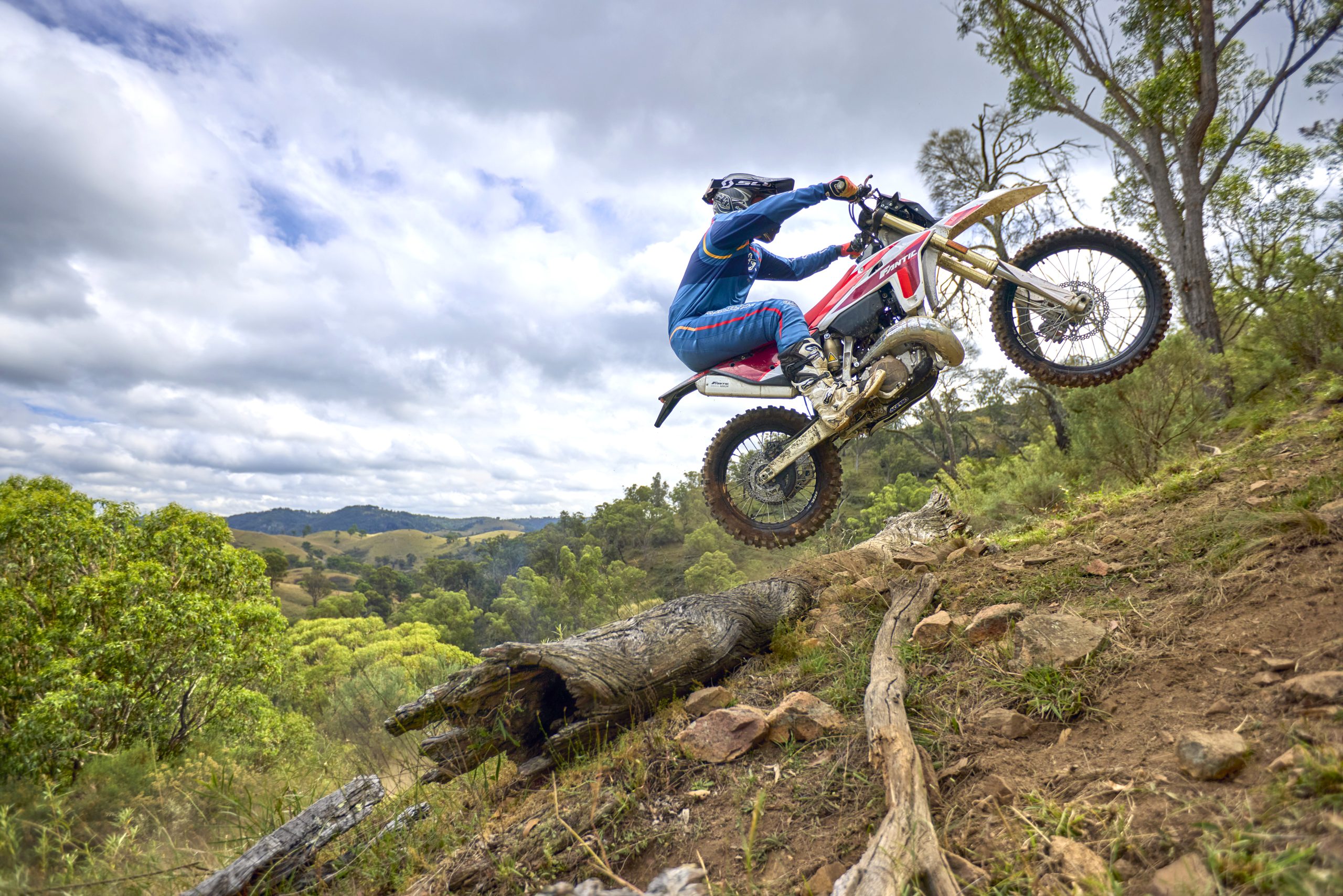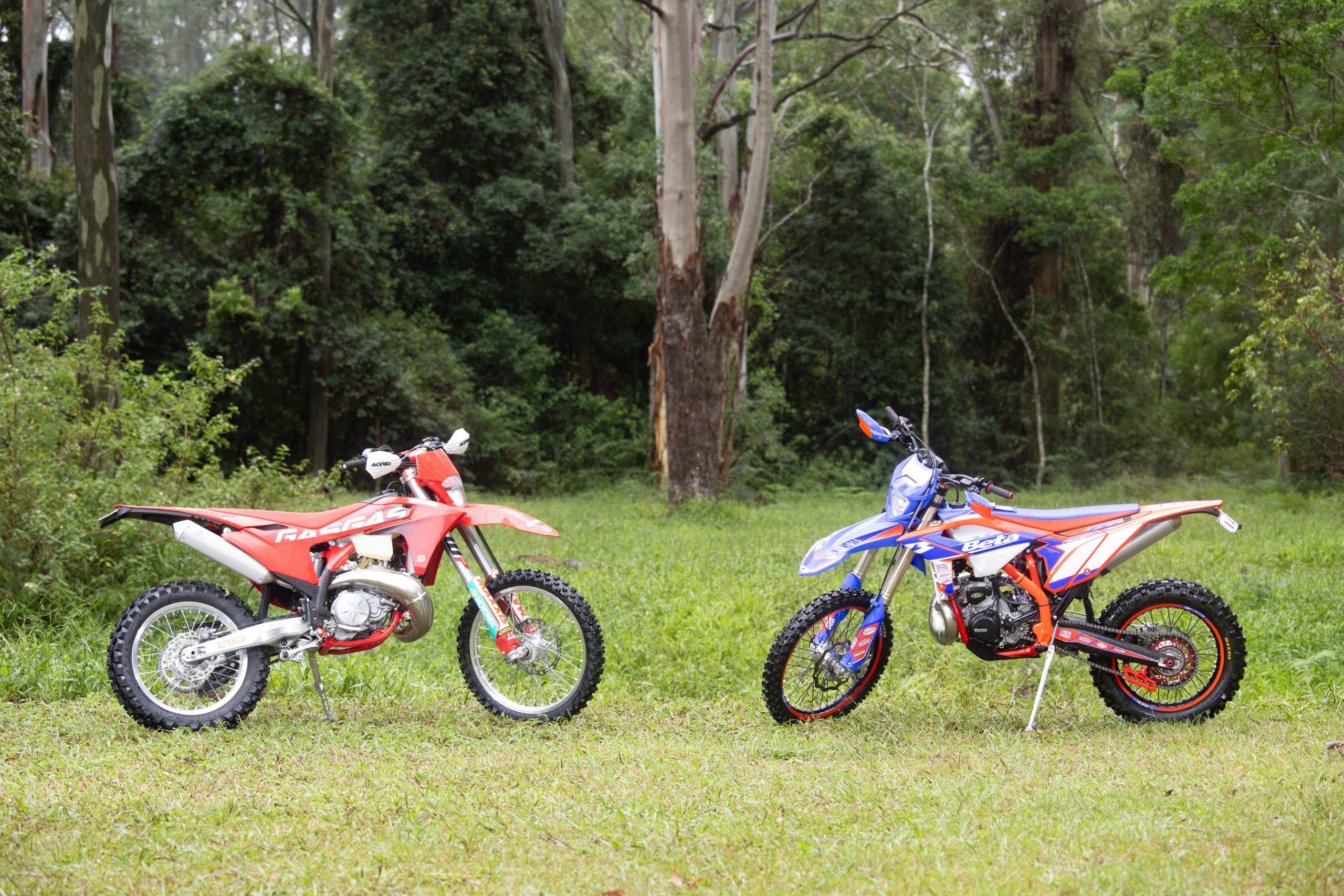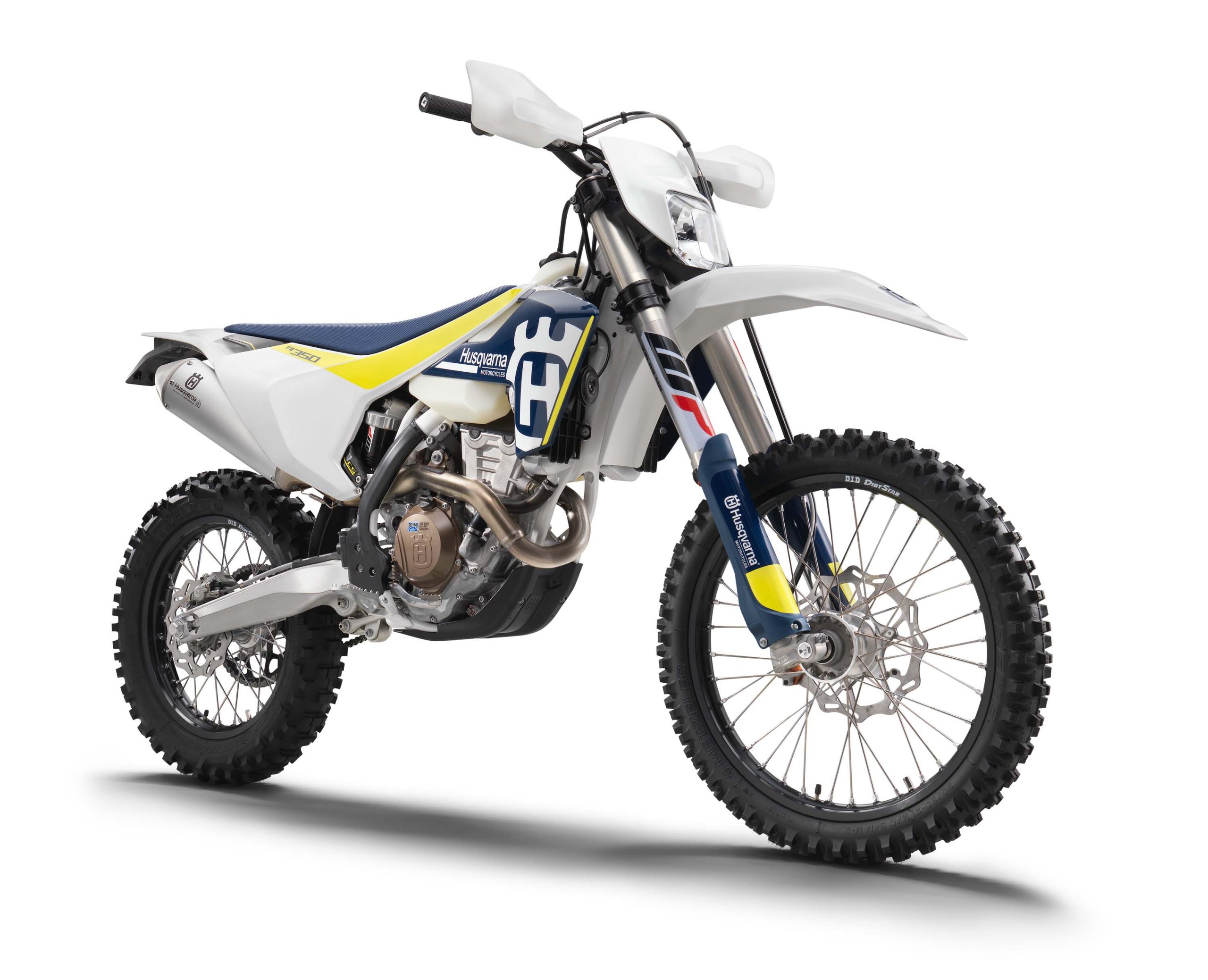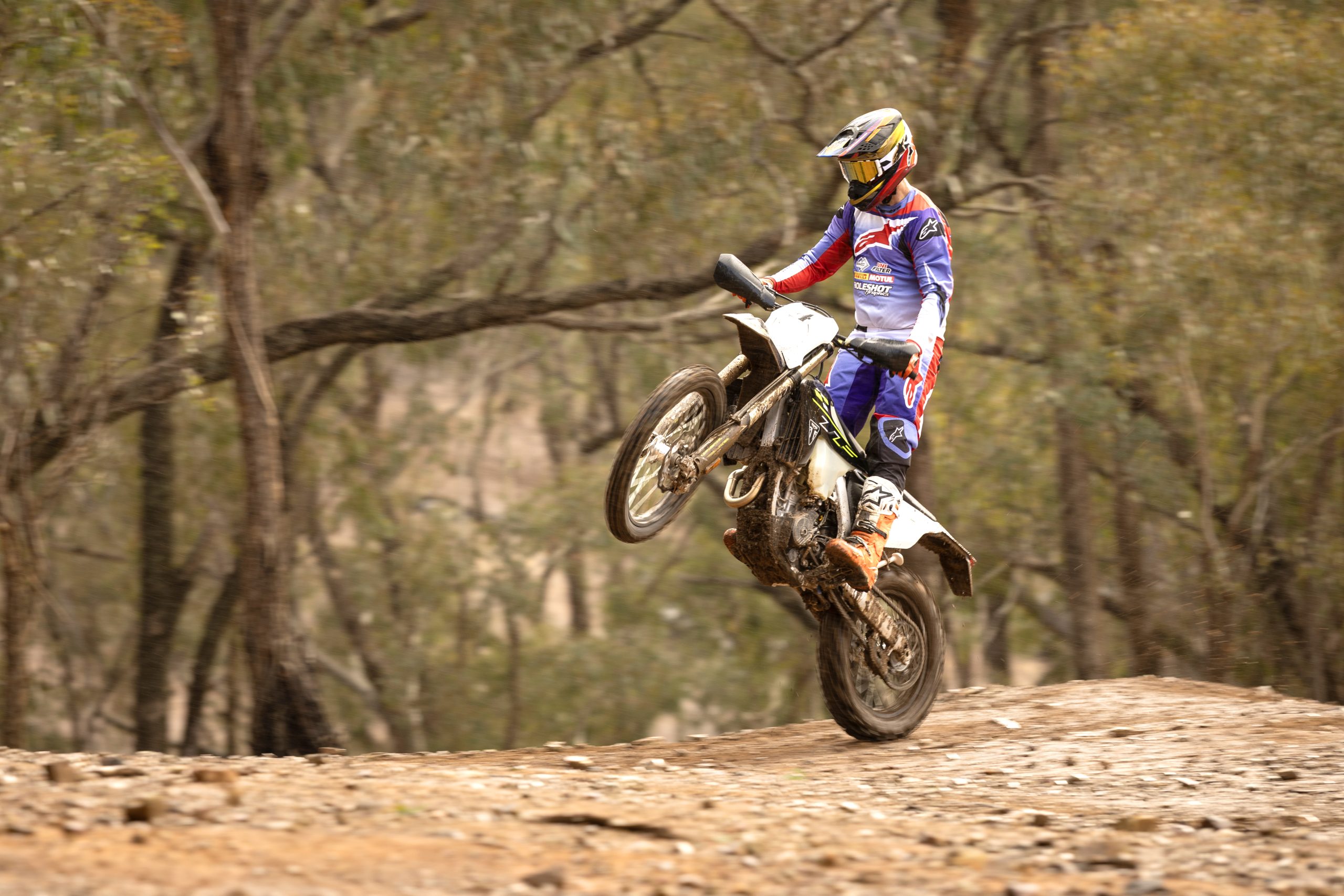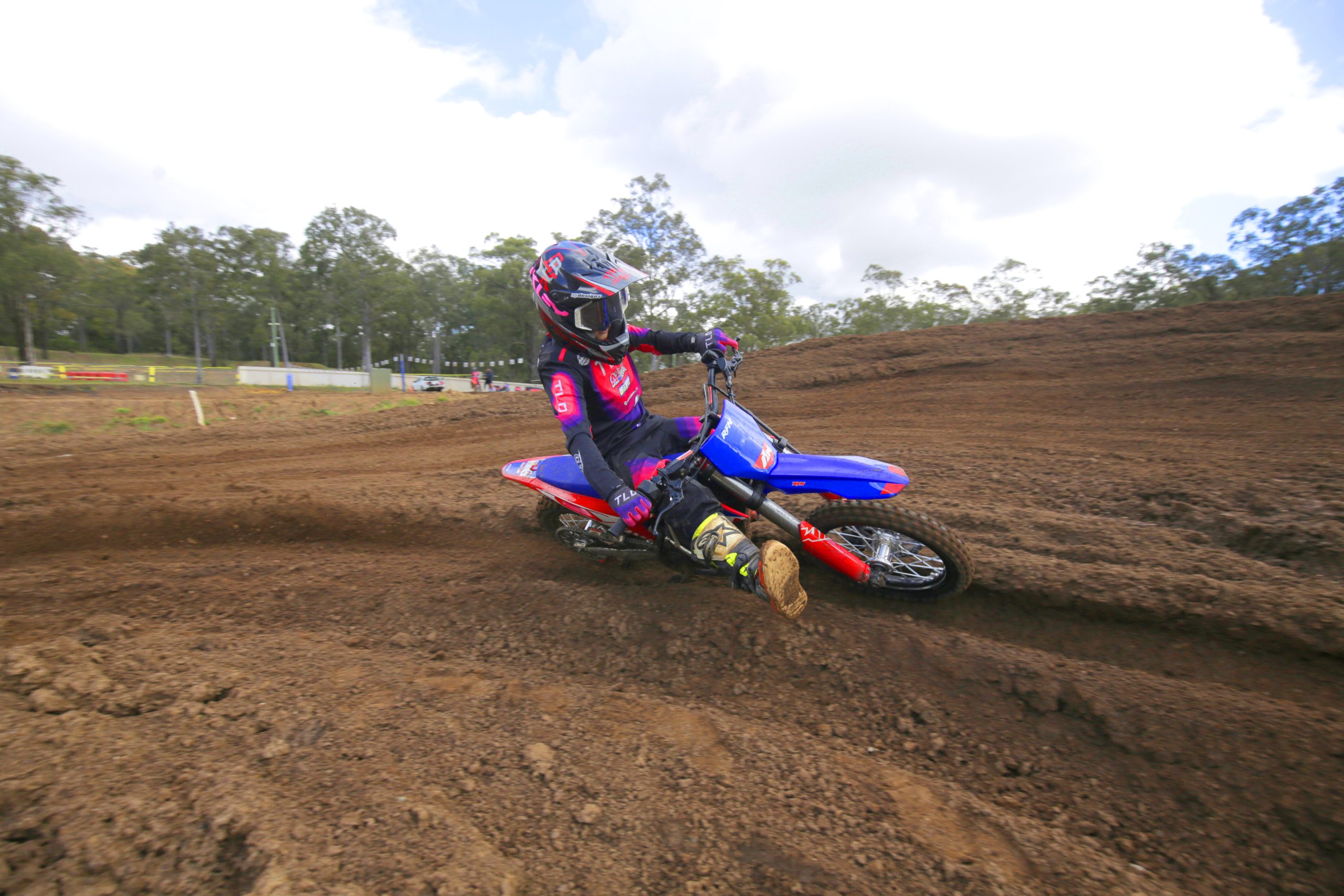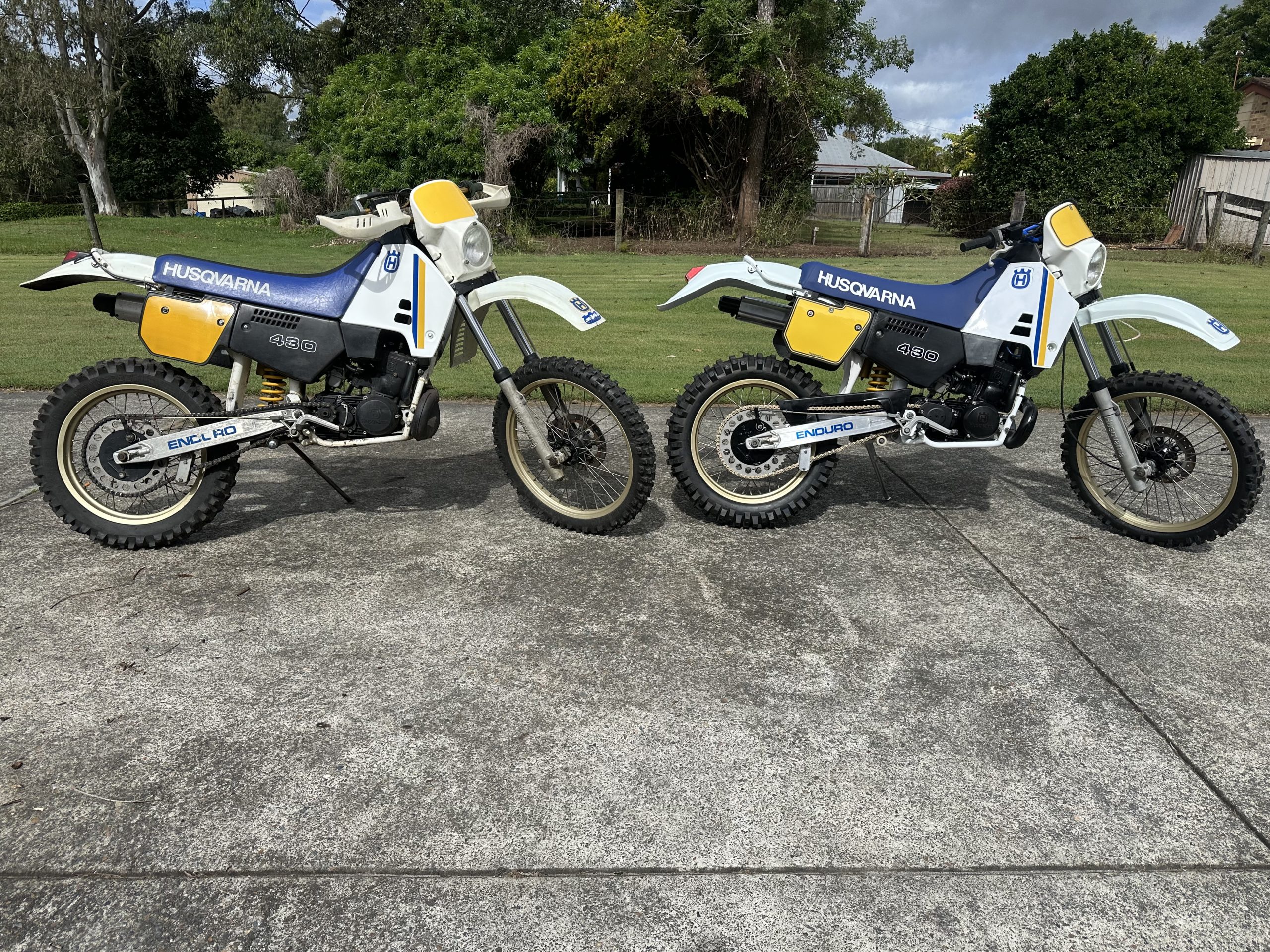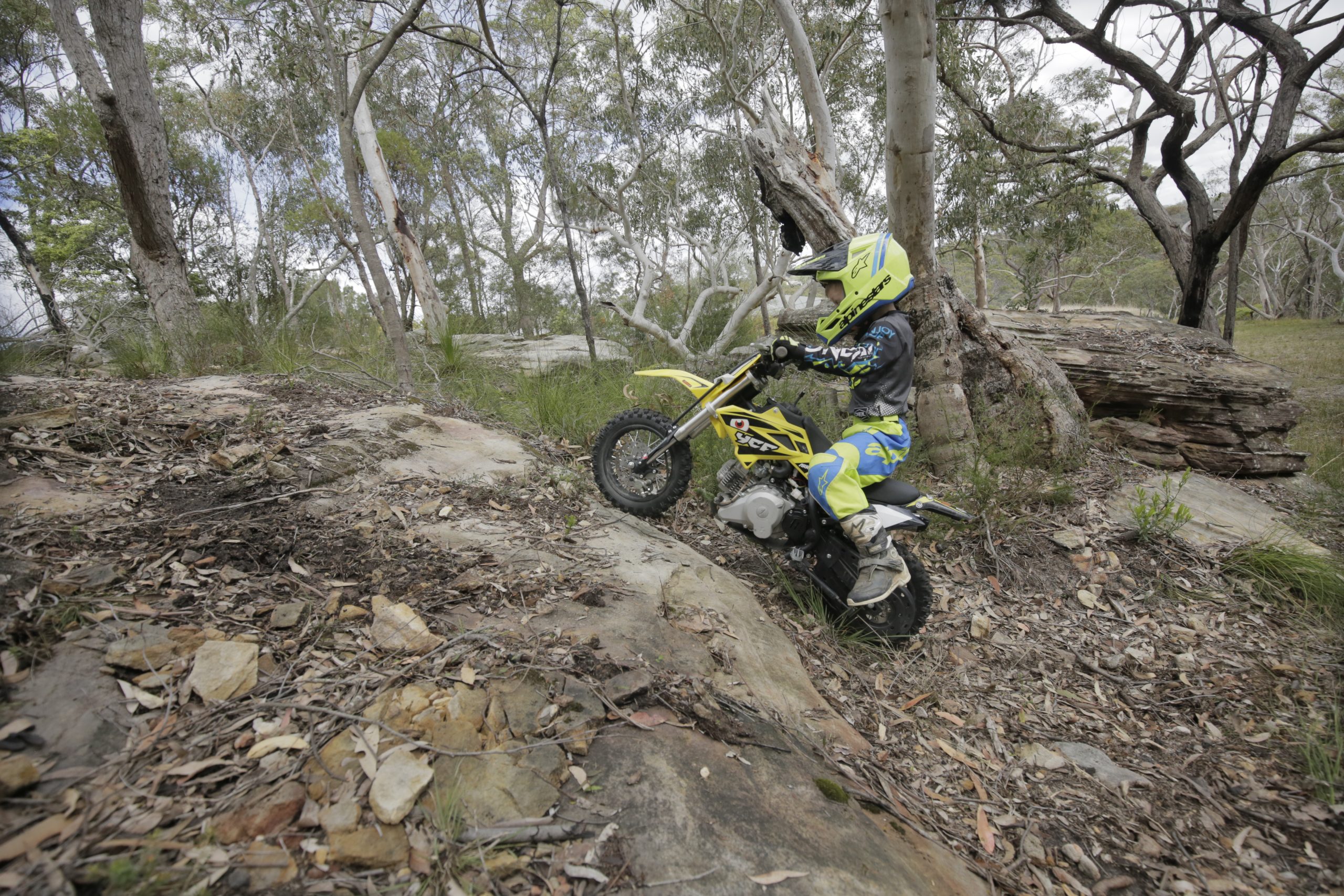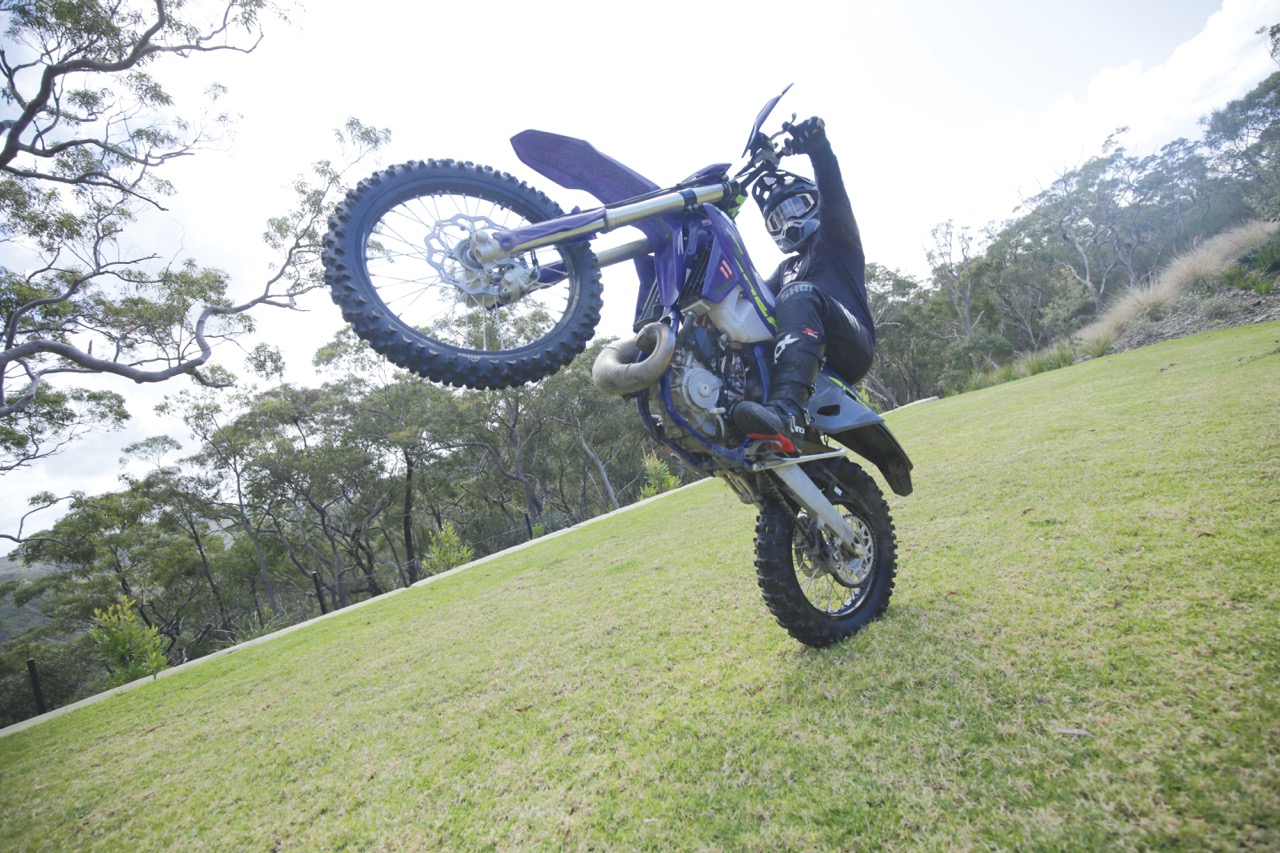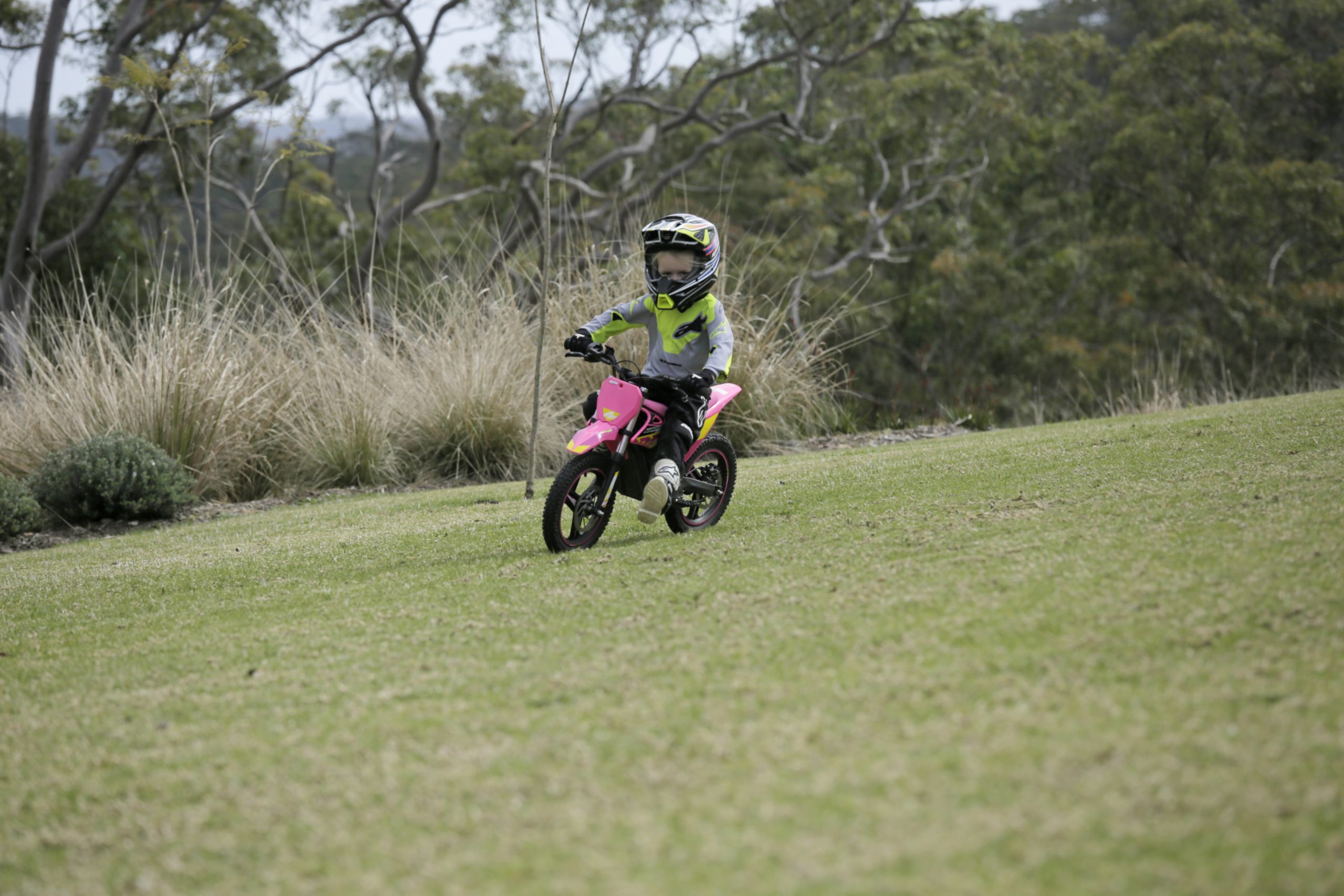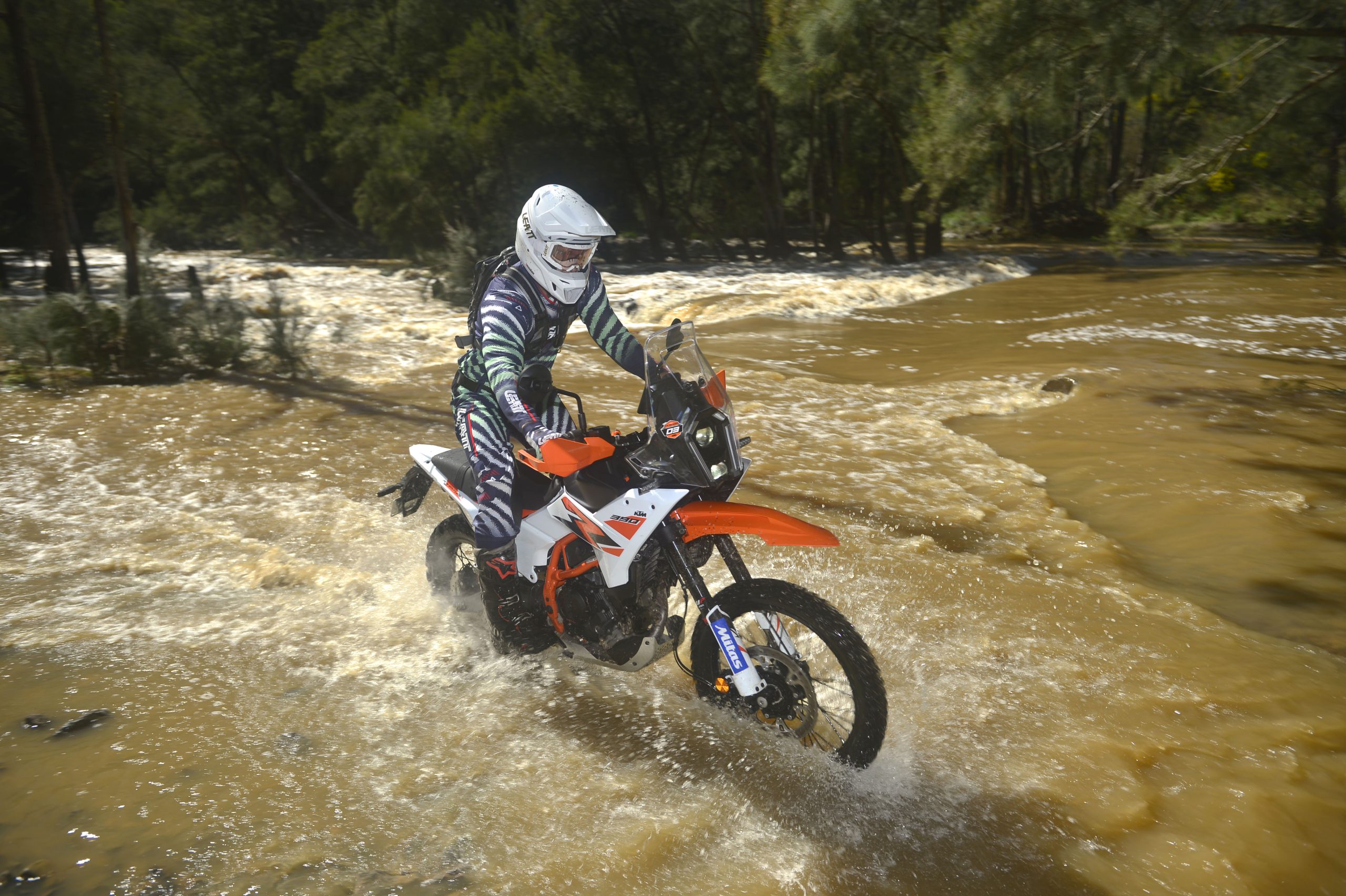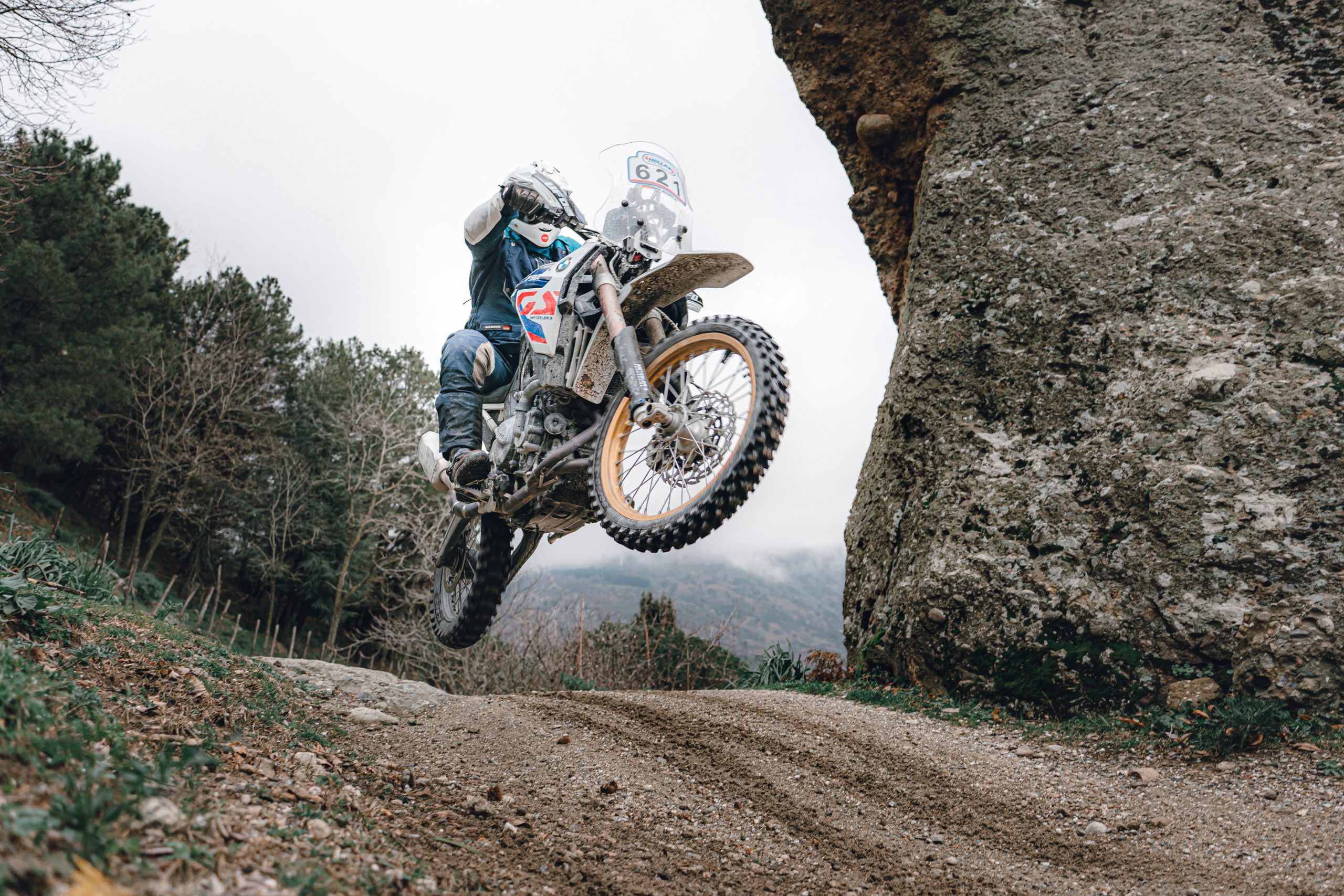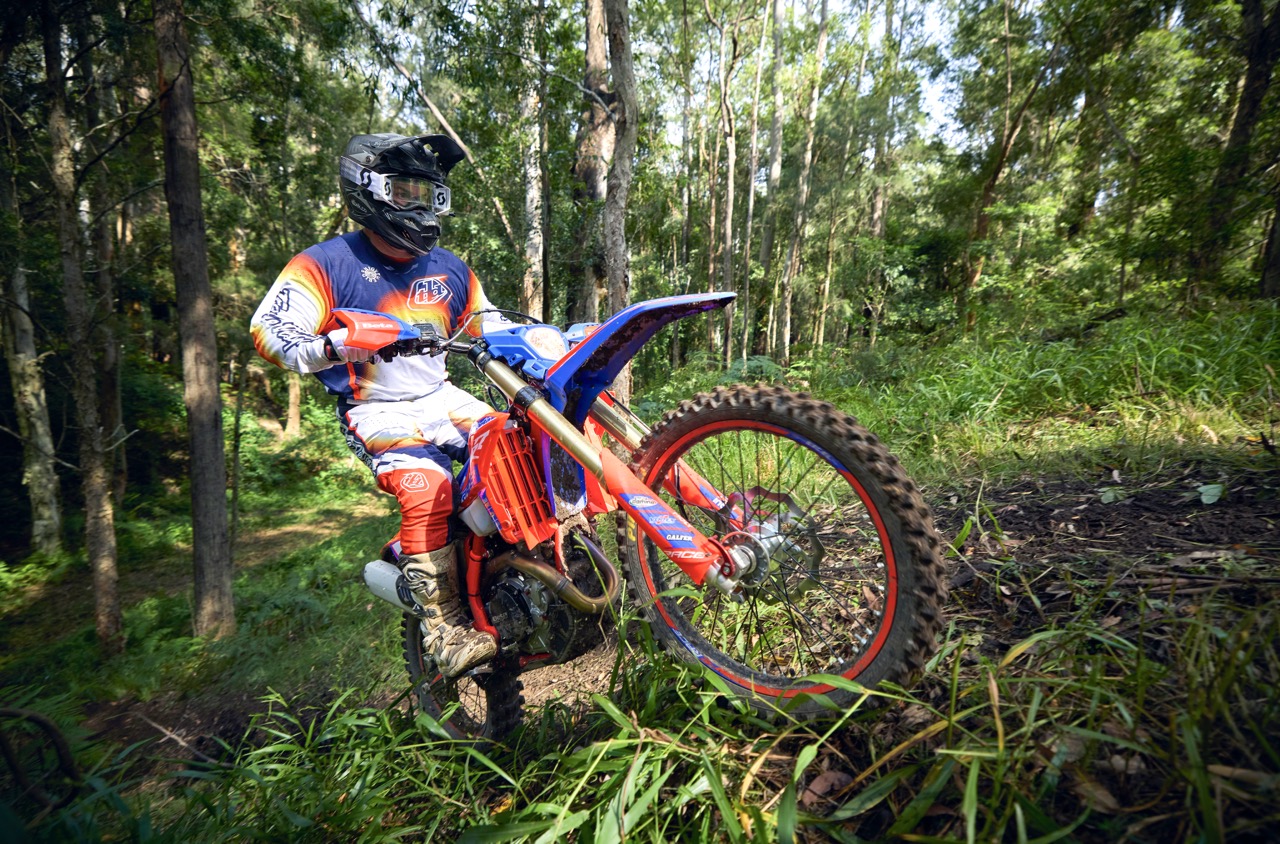Damn, it’s good to be back doing shootouts! It feels like an eternity since our last ADB enduro shootout, and what better way to get back into the swing of things than with a fresh fleet of brand-new 2025 300cc two-strokes? There’s no shortage of love for big-bore two-strokes in the Australian enduro scene, and this year we’re lucky enough to throw a leg over seven of the best 300 smokers on the market in this 300cc two-stroke trail shootout.
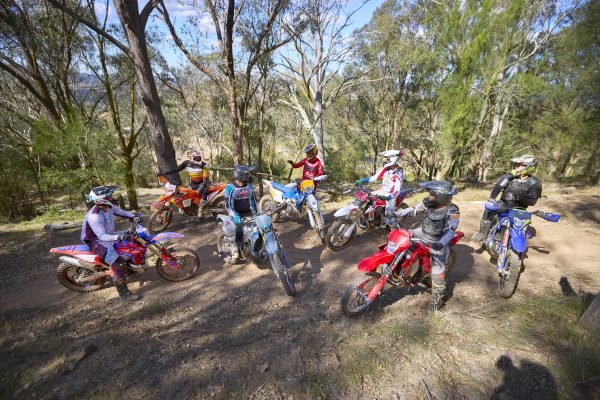
And yep – if you’re wondering – we’ve officially gone crab-crazy with shootouts for 2025. The 450cc motocross shootout is already in the bag, the 250cc motocross shootout is done and dusted, and now it’s time for the 300cc two-stroke trail enduro shootout. But we’re not stopping there – a 300cc two-stroke hard enduro shootout will follow, then we’ll round things off with a 450cc enduro shootout. It’s been a massive effort pulling this many bikes together – but bloody hell, it’s been worth it.
The reason we’ve doubled up on shootouts for the 300cc two-stroke enduro class is because it’s the only bike in the market with such a versatile skillset. It can be used for racing flat-out off-road and trailriding for days on end with your mates, or grovelling up hills at a snail’s pace and launching up rock ledges without a care in the world. Because the two genres are so different, we couldn’t combine the tests on a scorecard. One bike might be awesome flat-out but terrible crawling up hills, and if the winner was the bike that loved going fast and someone purchased it for hard enduro, they’d be hunting us down to launch the bike through out front door! So, we have the 300cc two-stroke trail shootout now and next issue we will have the almighty hard enduro shootout.
The 300cc two-stroke market is easily the strongest off-road segment in Australia, and for good reason. For years now, some manufacturers have sold more 300s than any other bike in their range. Aussies love their 300s – that’s just a fact. But why? Is it the unbeatable power-to-weight ratio? The simplicity and ease of maintenance? The glorious, raspy bark of a two stroke on the pipe? Or is it all of the above – and then some? Those were exactly the questions we wanted to answer heading into this shootout, and to say we were champing at the bit to get started would be an understatement.
The 2025 line-up is a beauty: seven finely tuned machines from five different manufacturers. Surprisingly, only three of the bikes are carburetted, with the rest running fuel injection. Honestly, I never thought we’d see the day when injected bikes outnumbered carby bikes in a 300cc two-stroke trail shootout. And even TM (who supplied its carb version for this test) also offers an injected version now – meaning we could’ve had just two carburettor bikes! Wild times. This kind of variety is what makes these shootouts so exciting: so many different personalities, so much trick gear bolted onto the bikes and so many options depending on what type of riding you’re chasing.
The only missing piece? The new MY25/26 Rieju MR300. Unfortunately, there were none in Australia at the time of testing – but we’re hoping to get our hands on one soon for a standalone test.
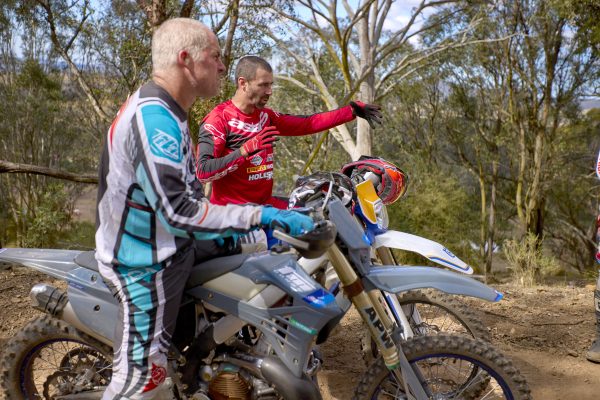
LOCATION
As mentioned, day one was all about race/trail riding, while day two will focus purely on hard enduro (we’ll cover that in the next issue). For day one, we headed out to the Goulburn Moto Complex, where we put the bikes through their paces on the sprint enduro loop and Amcross track.
The sprint loop was no walk in the park: tight and twisty singletrack with heaps of elevation change, tricky off-camber sections, open grassy straights to wind the big 300s right out, plus a healthy dose of bulldust and technical rocks. It was a genuinely tough, varied test loop. After a full lap of the sprint loop, we capped things off with a spin around the Amcross track – the perfect setting to really wring the bikes’ necks, singing that glorious 300cc two-stroke symphony out loud.
Stay tuned for the day two hard enduro results – but for now, it’s time to see how the 300s stacked up on the race/trail battlefield.
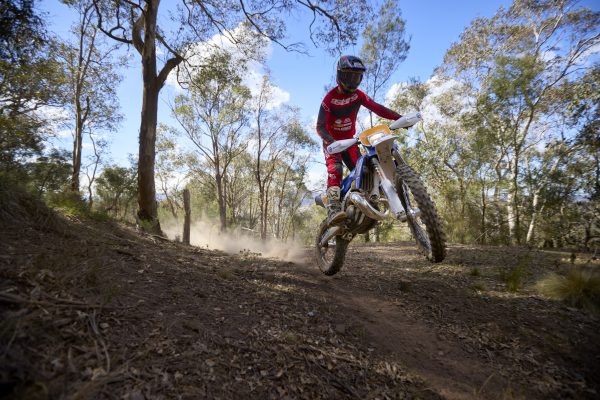
THE SCORECARD
In all our previous shootouts for MY25, we have had each of the manufacturers represented by a particular rider. We didn’t do that for this shootout as this is mostly about trail riding, and trail riders aren’t exactly sponsored! But we do pick riders who are unbiased and who own and ride different brands. When it comes time to score the bikes the riders allocate scores in multiple categories for each machine. The scores are split into three categories which are weighted, comprising Engine (50%), Suspension/Steering (40%) and Ergos/Brakes (10%), with each rider giving a score out of 10 for each category.
Husqvarna TE 250 Heritage Edition

Wait a second – a 250cc two-stroke? What the hell is going on here?
Okay, so here’s the deal: unfortunately, Husqvarna Australia didn’t have any TE 300s available, so rather than pulling out completely, it decided to field a 250 two-stroke instead. Bold move on its part – but hey, we weren’t complaining when we were greeted with a 2025 Husky TE 250 Heritage Edition machine.
Now, what exactly is a Heritage Edition? Well, it’s essentially a well-dressed TE 250 with sweet-looking plastics and a special graphics scheme. You get blue shrouds, a blue seat cover, and some unique logos – maybe a bit much for some to be calling it a “heritage” model, but honestly, it’s a nice touch to separate these bikes from the regular stock line-up. Underneath the fancy skin, it’s built on Husqvarna’s proven central double-cradle-type 25CrMo4 steel frame, paired with an aluminium-reinforced polyamide rear subframe – a solid, modern platform.
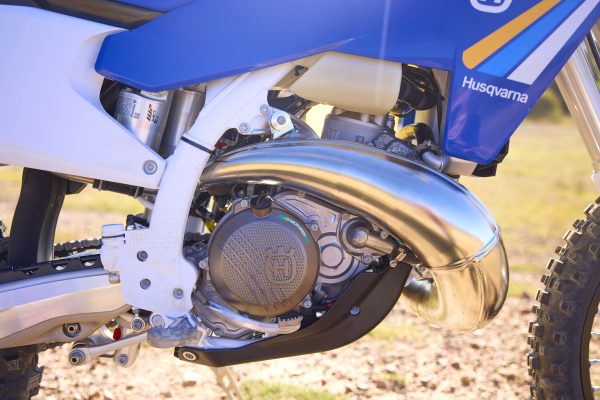
And yes, I get it – you’re still probably asking why even bother bringing a 250 to a fight against a bunch of 300s? Surely, it’ll come last, right?
Well, surprisingly, there are things a 250 does better than a 300, and it actually makes them really appealing to some riders. For example, the TE 250 feels lighter and more nimble out on the track because of the smaller engine mass. With a weight of 107kg (without fuel), it’s a kilo or two easier to throw around – something you really notice when you’re tired after a long day in the saddle. Having the 250 in the mix made for a very interesting comparison, and the TE 250 put up a much stronger fight than we expected.
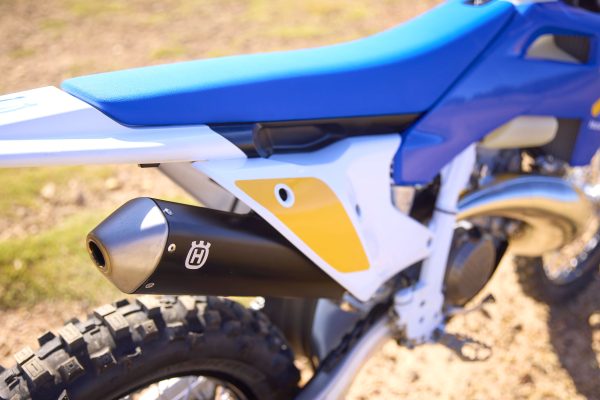
The engine was the dark horse of the shootout. Even being a smaller capacity bike (249cc to be exact), the little Husky’s one-cylinder, liquid-cooled two-stroke engine didn’t get left behind. Thanks to its smooth delivery through the Keihin 39mm throttle body and the updated Vitesco Technologies EMS for 2025, the power was crisp, torquey and surprisingly strong right off the bottom.
Despite having less rotational mass compared to a 300, the TE 250 revs faster, yet still maintains a strong and useable power curve that stays clean and lively from bottom to top. And more importantly – finally – no weird lean surges or hanging revs like we used to get with the early TPI and even some early TBI bikes. The fuel-mix generation is absolutely on point now.
If we move onto handling, the Husky is definitely up there with the top-tier machines in this class. Much of that is thanks to the excellent WP suspension package – the latest 48mm WP XACT closed-cartridge fork up front and a WP XACT monoshock with linkage at the rear. Both ends deliver a healthy 300mm of travel.
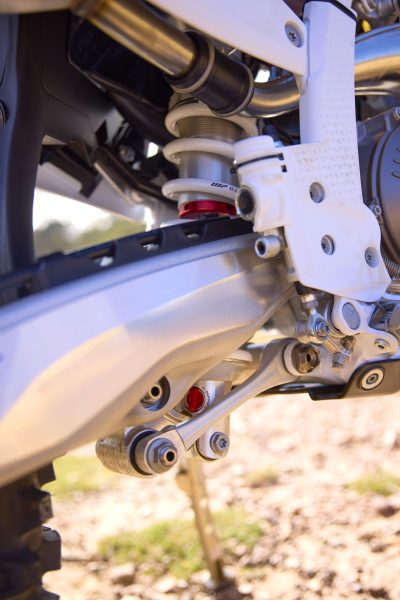
Gone are the days of super-soft WP front ends. The new suspension wants you to push harder, ride faster and feel comfortable doing it. The bike’s linkage system offers excellent drive out of corners, keeping it settled and composed even when traction gets sketchy.
Add in a nicely balanced chassis, a 1489mm wheelbase, a ground clearance of 343mm and a steering head angle of 63.9°, and you’ve got a machine that feels extremely predictable and easy to ride, no matter what you throw at it.
The fit and finish on the Husky is second to none. Practical touches like the ProTaper aluminium handlebar, a compact wet DDS multi-disc clutch with Brembo hydraulics, and spoked wheels with lightweight aluminium rims show the attention to detail.
The hydraulic map-select switch is another big bonus – letting you quickly switch to a softer map if track conditions go south. The braking package is excellent too, with a 260mm front and 220mm rear brake disc setup delivering predictable, powerful stopping performance.
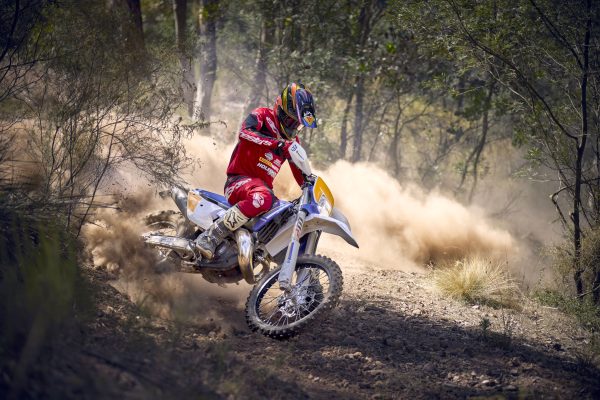
Fuel capacity sits at 8.5 litres, and while the TE 250 doesn’t run the biggest tank of the group, it’s plenty for long trail days or a few enduro special tests.
The aluminium silencer keeps things lightweight without muting the glorious 250cc bark too much.
Overall? The 2025 Husqvarna TE 250 Heritage Edition held its own impressively well in a class full of bigger-bore bruisers – and showed exactly why some riders will always have a soft spot for the sweet-handling, fast-revving feel of a 250.
KTM 300 EXC Champion Edition

First and foremost – this bike wins the best-looking category for me and the rest of the boys. The Champion Edition scheme is awesome, with the full Red Bull CTG graphics, orange frame and factory seat making the bike absolutely scream factory weapon. It’s the most expensive bike of the group, sure, but when you look this good, who’s counting?
Underneath all that glam, the 2025 KTM 300 EXC Champion Edition runs the same engine platform as the GASGAS and Husqvarna, meaning it’s built around the latest throttle body injection (TBI) system. The 293.1cc one-cylinder two-stroke engine uses a Keihin 39mm throttle body, with fuelling controlled by a Vitesco Technologies EMS, and a wet DDS multi-disc clutch handled by Brembo hydraulics. It’s fired up by an electric starter and keeps its cool via a liquid cooling system, which all bolts into a lightweight 25CrMo4 central double-cradle frame.
Now, it’s no secret that I haven’t been a huge fan of KTM’s injected two-strokes over the last few years – sluggish bottom end, weird fuelling and none of that old-school snap from the carby days. But to my surprise (and everyone else’s), the 2025 TBI platform is night and day better than the 2024 version. Whatever the engineers did – it worked. No bogging, no hesitation, no dirty-feeling ‘jetting’. It’s torquey enough to claw you out of trouble but still fast enough to light up your grin, whether you’re crawling up a rocky hill or hammering down a grass track. It’s easily the best version of the TBI system KTM has produced to date.

In fact, this was the first time I thought the KTM 300 EXC felt genuinely close to the old Keihin carburetor days – and that’s a big call from someone who’s been a staunch carb fan for years. It still doesn’t have quite the same instant punch off the very bottom as a true carby bike, but it’s damn close. Managing the bike is easy too, helped by the Champion Edition’s stock gearing of 14/45 (secondary gear ratio) – matched perfectly to the new engine character.
Handling-wise, the KTM feels taut and planted, and that’s largely thanks to the suspension updates. Up front, the bike runs a WP XACT closed-cartridge 48mm fork offering 300mm of travel, paired with a WP XPLOR PDS shock delivering 310mm at the rear. While the bike still retains the active feel of a PDS setup (no linkage), the rear doesn’t dance around nearly as much as older models did. Traction out of corners and drive up nasty hills is brilliant, and overall it’s just way more confidence-inspiring.
Some riders might find the new stiffer feel a bit firm compared to plush trailbikes, but honestly, it was a big hit among our testers – especially for anyone who likes to push the pace.

Ground clearance is tall at 347mm, and the wheelbase sits at a stable 1489mm, with a steering head angle of 63.9°, helping the bike stay composed whether you’re threading tight singletrack or charging open turns.
Ergos were another win, with the slim bodywork, grippy factory seat and Neken aluminium handlebar (28/22mm) combo making it super easy to feel connected to the bike. Standing or sitting, it’s effortless to move around.
The Champion Edition spec also adds a few trick extras straight from the factory: an orange front axle puller, semi-floating front brake disc, Supersprox stealth rear sprocket, skid plate and frame protection set – all of which add durability and make you feel like you’re on a true works machine.
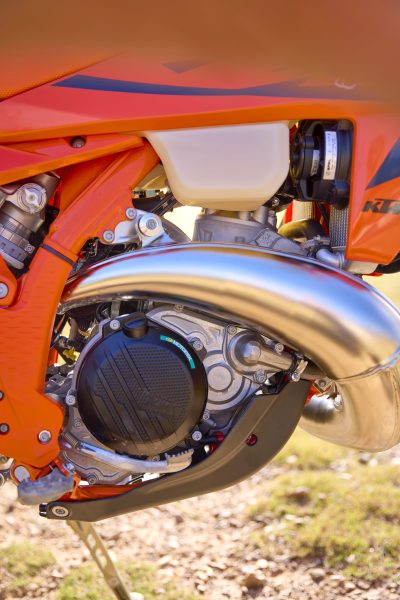
Braking is classic KTM quality, too. The front brake runs a strong Brembo system with a 260mm disc, and a 220mm disc out back, delivering heaps of power and control – especially noticeable on the hard, fast Amcross sections.
Fuel capacity sits at nine litres, giving you good range for anything from trail rides to sprints. And when the conditions change, the map-select switch lets you flick between different ignition curves – although the new button placement isn’t the most intuitive and feels a bit fiddly compared to previous models.
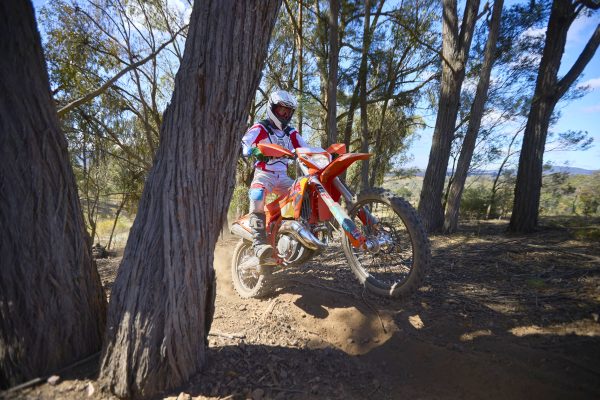
Rolling on a 1.60 x 21 front and 2.15 x 18 rear wheel combo, wrapped in 90/90 and 140/80 tyres respectively, the KTM Champion Edition feels ready for anything – tight and technical or fast and flowy, this bike thrives wherever it’s pointed.
Overall? The 2025 KTM 300 EXC Champion Edition is hard to beat as a total package. It’s lighter (at 104.9kg without fuel) than a lot of bikes in the category, runs a crisp, clean engine that’s finally hit its stride, and comes straight out of the box dripping with trick bits. Whether you’re racing, trail riding or just blasting around with your mates, this thing feels like a winner.
TM EN 300 Carby Corse
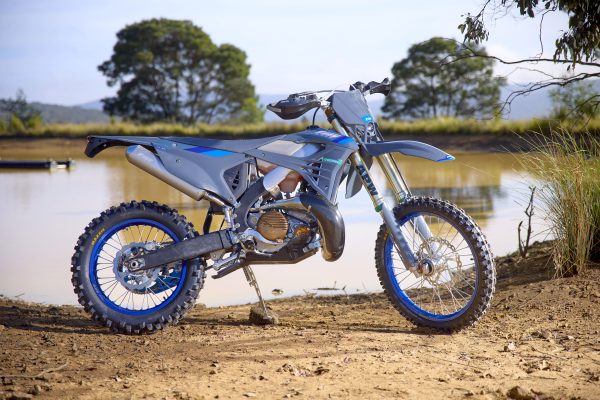
Onto our first exotic bike of the day now with the new 2025 TM EN 300 Carby Corse at our disposal.
I say exotic because these Italian weapons are definitely an acquired taste among the enduro community, and there aren’t huge numbers of them brought into Australia. In fact, so few that for this shootout this bike was actually loaned to us by an <i>ADB<i> reader – massive thanks to Jason for trusting us to ride your brand-new machine!
Now, if you haven’t heard of TM before, it’s a small Italian brand that’s been around since 1976, when two childhood friends decided to quit their jobs and start building motorcycles. TM has grown into a boutique powerhouse, offering eight motocross and six enduro models, plus a range of factory-built engines and karting projects.
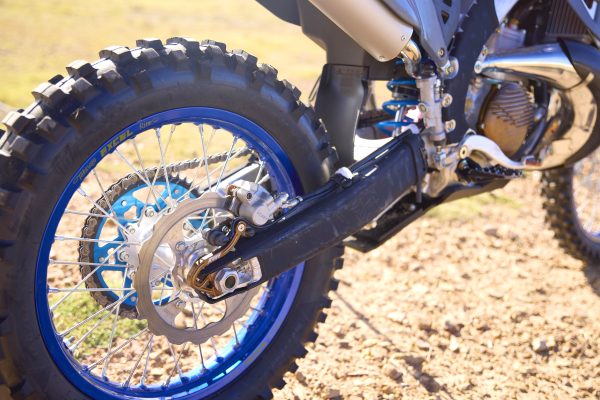
The bikes are dripping with handmade parts and billet goodness, making them stand out from the big manufacturers. And impressively, the TM EN300 two-stroke is available in two configurations: a carburettor model, like the one we tested, and an EFI version. While we only managed to get our hands on a carby bike this time, hopefully a test of the EFI model will happen soon.
At the heart of the TM is a beefy 293.2cc two-stroke engine featuring hand-finished crankcases, a TM Moto 39mm carburettor (yes, glorious carbs live on), a TM-designed throttle body, VForce reeds, an HGS exhaust and an electronic power valve setup. It’s topped off with a counter-balancer to help tame the vibration and keep the ride smooth.
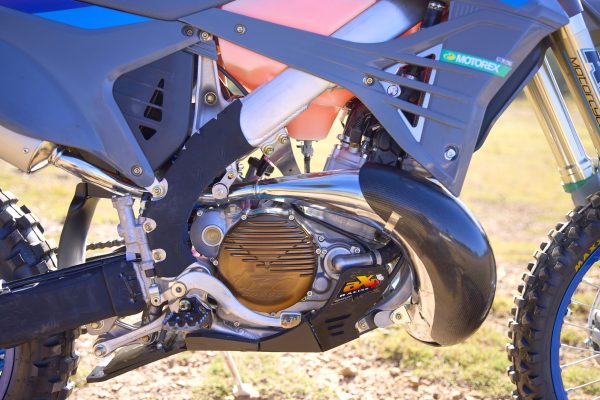
The engine runs an Emoticom ECU and is paired to a six-speed gearbox, with electric start as standard. No kickstarter needed here – just hit the button and off you go.
The chassis is just as exotic, using a self-tempering aluminium Deltabox frame with a single-beam design and forged details – a real standout compared to the steel frames of the rest of the group. The TM tips the scales at just 100kg (without fuel), making it one of the lightest bikes here, and giving it razor-sharp handling in the right conditions.
On the suspension front, the TM runs a 48mm KYB closed-cartridge fork up front with 310mm of travel and a TM Moto-built shock out back offering 300mm of travel. Ground clearance is generous at 355mm and the seat height sits tall at 985mm, making it a bit of a reach for shorter riders.
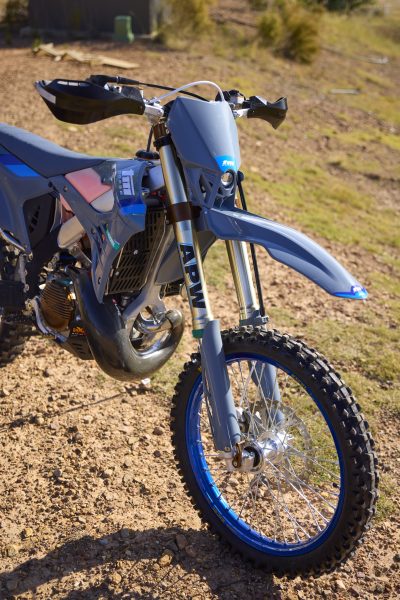
The steering head angle is a quick 63°, and it rolls on the classic 21-inch front and 18-inch rear wheel setup.
Visually, the new Corse grey plastics kit really sets the bike apart from the crowd. Add in billet triple clamps, high-end Brembo front brakes (with a 270mm front disc), a Nissin rear brake setup (with a 242mm disc) and a Regina ZSA chain, and you’re getting a full boutique-spec build straight from the factory.
So – it looks sweet. But how does it ride?
Well, first off, the TM feels the most ‘European’ of the bunch – and not in a bad way, but it’s noticeable. The riding position is a bit different, with a higher handlebar bend and shorter gear/brake levers that might take some getting used to. It’s not uncomfortable per se, but compared to the more homogenised feel of the other six bikes, the TM definitely stands out. An aftermarket ’bar would likely sort it out for most riders.
As for performance, the engine is an absolute weapon when you open it up. The bottom-end power is a little lazy – classic big-bore two-stroke style – but once it hits the midrange, it absolutely rockets and keeps pulling hard into the top end.
We did some minor jetting tweaks to clean up the low-end response, which helped, but make no mistake – this bike loves to be revved.
For long trail rides, that aggressive mid-to-top charge might wear some riders out, but for special tests, sprints or Amcross track days? It’s a total blast.
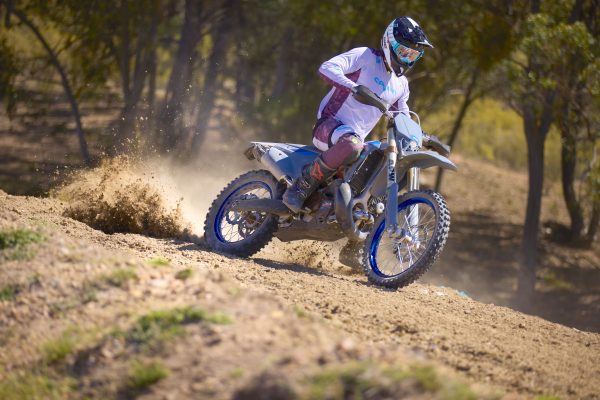
Handling-wise, feedback was mixed. Some testers loved the firmer front-end feel of the KYB CC fork, especially at speed where it gives great support. Others found the bike a little harsh in slow, choppy terrain. The TM Moto rear shock performed well across most conditions though, providing good drive and composure at higher speeds.
That initial bog off the bottom end sometimes created a bit of a seesaw effect when exiting corners, requiring riders to be aggressive to keep the bike settled – but with a little more tweaking, this thing would feel seriously dialled front to back.
Overall, if you’re chasing something truly unique – a bike that looks exotic, rides raw and gives you that boutique factory bike feel – the TM EN 300 Carby Corse could be right up your alley. It’s sweet to look at, packed with trick parts and with a little personal tuning it could easily become a real showstopper.
Fantic XE 300
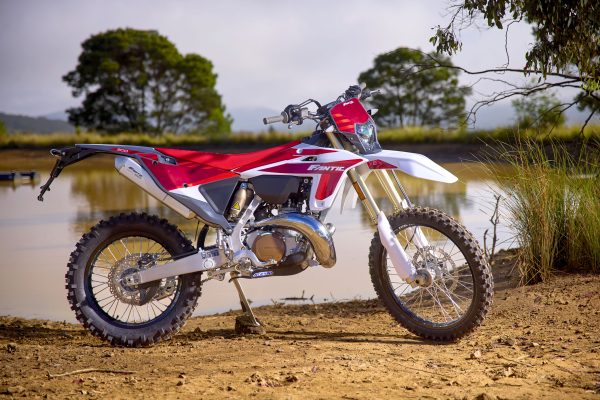
Well, here’s another interesting machine to say the least. Probably the most unknown and most anticipated bike of the entire day: the Fantic XE 300.
Fresh off the boat and only very recently becoming an option for Australian riders, this bike had the most questions hanging over it before we even kicked a starter.
So, is it a Yamaha? Well, yes… and no… at the same time.
Fantic Motorcycles has had a long-standing partnership with Yamaha, using the YZ platform over the years and then giving it the full Fantic treatment. It’s a pretty cool partnership if you ask me! Now here’s the kicker: for years, people have been asking why Yamaha doesn’t build a 300 two-stroke – and with the release of the XE 300, you’re looking at probably the closest thing to a YZ300 you’ll ever get.
That Yamaha connection, however, pretty much ends with the chassis, suspension and brakes. The engine, tank, airbox, plastics, exhaust, radiators, seat, electronics – they’re all Fantic built.
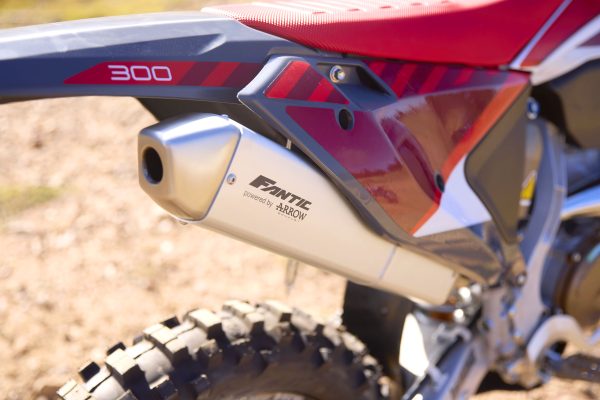
The XE 300 uses an aluminium semi double-cradle frame, combined with an aluminium rear subframe and a progressive-link aluminium swingarm, carrying over the proven handling DNA of the YZ while modernising the platform with Fantic’s own Italian flair.
And I have to say, the bike does look bloody awesome – sharp, aggressive lines, full LED front and rear lights, and that typically slick Italian finish. Fantic is even claiming that it’s the most powerful bike in the class. Bold claim for the new kid!
Powering the XE 300 is an Italian-built Motori Minarelli engine – a liquid-cooled, single-cylinder two-stroke with reed valve intake and an electronically controlled exhaust valve. Displacement is bang on at 292.9cc, with a bore and stroke of 72.0mm x 72.0mm, and it runs indirect fuel injection with twin throttle body injectors.

It fires into life instantly via an electric starter, and lubrication is handled by a separate oil mixer – no pre-mix hassles here. A five-speed gearbox handles the shifts, and the clutch is a wet multi-disc unit with hydraulic control using an STM actuator and a Brembo master cylinder.
One thing to note: it’s only a five-speed, not six, because the crankcases are based off the YZ250 platform. It might be a dealbreaker for some trail riders, but for us, we were just keen to ride this new beast.
On track, the XE 300 immediately feels familiar – the aluminium chassis gives it that classic planted YZ feel. The wheelbase stretches 1485mm, and it’s nicely balanced with a caster angle of 27.7° and 122mm of trail, giving it solid, confidence-inspiring steering without being twitchy.
Weight is claimed at 107kg without fuel, and the nine-litre tank means you’ll get plenty of riding in before needing a refill.
The engine itself is strong, but the initial bottom-end power delivery left a little to be desired. There’s not a lot right off the bottom, and you have to work the hydraulic clutch and your body position to get it moving crisply.
We asked the Fantic crew about it – turns out there’s an app and mapping adjustments available, but unfortunately they weren’t ready for us to use yet, s it’s a to-be-continued situation at this stage.
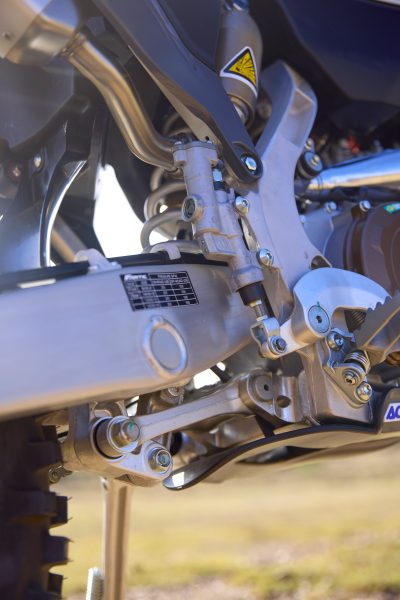
Once you get past that slightly sluggish bottom, the XE 300 comes alive. The midrange and top-end pull are strong, and the twin injector system delivers super crisp throttle response when you keep the bike singing in the higher revs.
It’s an engine that loves to be ridden aggressively. It can be a little tiring if you’re not in the mood for it, but man, when you’re on the gas, it’s a lot of fun.
The dual-map switch on the ’bar – offering a ‘hard’ and a ‘soft’ map – made a noticeable difference too. Most of us preferred the aggressive map on day one, as it woke up the bottom-end and gave the bike a more lively feel.
As you’d expect, the KYB suspension on the Fantic is excellent. The 48mm fully adjustable SSS fork offers 300mm of travel up front, and the rear shock delivers 315mm of travel. It’s a firmer setup than some of the other bikes in the group, meaning it prefers a bit of pace to really shine, but it’s still forgiving enough to soak up smaller chop without beating you up.
Vibration was another point of difference: the XE 300 vibrates more than most of the other bikes, largely because it’s the only one here without a counter-balancer in the engine. It’s not deal-breaking, but it’s noticeable – and you can’t help but wonder how much more comfortable the bike would be if Fantic had fitted a balancer shaft.

Braking is sorted with quality components – a 270mm hydraulic disc up front and a 240mm disc out back – offering plenty of stopping power without being grabby.
The Fantic XE 300 is an excellent addition to the 300 two-stroke world. There’s no doubt that with more seat time and further development – particularly fine-tuning the bottom-end delivery – this bike could position itself right at the pointy end of the class.
The engine is strong, the chassis is proven, the suspension is sorted and there’s a genuine buzz around the brand.
Hats off to Fantic for throwing itself headfirst into the super competitive 300 class. It’s exciting to see – and even more exciting to ride.
Sherco 300 SE Factory
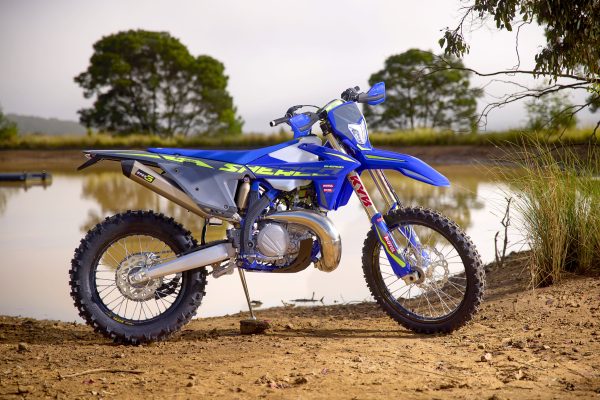
This bike has been a serious contender for the 300 two-stroke crown for several years now, and for 2025 the French manufacturer has sharpened the package even further. The 300 SE Factory has been given a chassis makeover, plus a whole host of upgrades to boot.
The high-strength chrome-molybdenum steel semi-perimeter frame has been revised, shaving 250g off the chassis alone. The aluminium subframe is also 250g lighter, and the CNC triple clamps have been trimmed down as well.
Fresh plastics, a sleeker airbox with new side entry (now tool-less access, finally!), bigger yet lighter radiators with improved cooling, an updated wiring harness, a new cockpit display – it all adds up to about a kilo of weight saving.
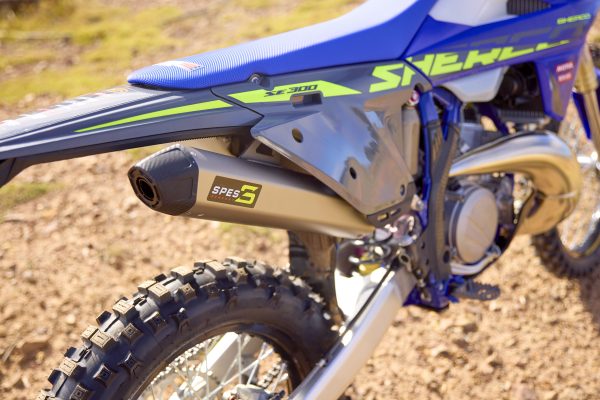
The engine itself remains largely the same as last year, but thanks to the updates to the airbox and cooling system, the 293.1cc engine feels a tad stronger. Bore and stroke are a classic square 72.0mm x 72.0mm, and fuelling is handled by the ever-reliable 36mm Keihin PWK carburettor feeding a VForce4 reed valve system.
Now, faster might not seem necessary for a 300 two-stroke, but the end result is a super torquey, extremely usable engine package. As one of only three carburetted bikes in the test, the Sherco uses the carb and its SBS electronically-controlled exhaust valve to great effect.
There’s a ton of grunt here, but it’s delivered in a clean, crisp way right from the get-go. The engine ran flawlessly, with no fluff or hesitation, and thanks to the electronic exhaust valve, it feels like the bike always has just the right amount of power ready to go.
Better yet, you can lug this thing all day through the nastiest terrain – it’ll crawl and chug without stalling, giving you loads of confidence on the technical sections.
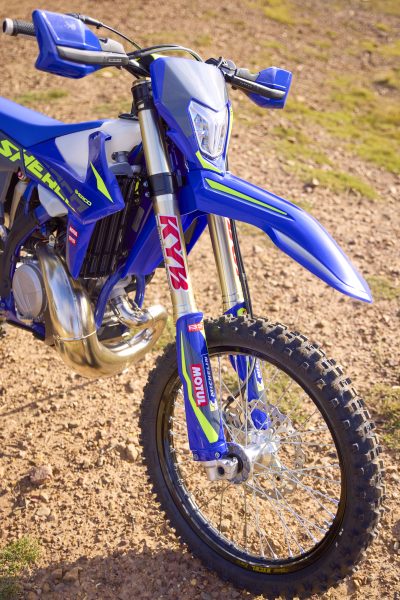
When it comes to handling, the Sherco is a weapon – and that’s largely down to the suspension. Up front you get a fully adjustable 48mm KYB closed-cartridge fork with 300mm of travel, and out back a big 50mm KYB shock with 330mm of travel, both with Sherco-specific settings.
Of the group, the KYB fork package on the Sherco was one of the real standouts. It’s plush enough to handle small chop and trail litter, yet firms up predictably as you load it through jumps or fast G-outs. The rear shock complements the fork perfectly, delivering excellent drive and traction everywhere we pointed the bike.
The bike does sit a little higher in the rear compared to some of the others – not a huge deal, but we did run a little more sag in the shock to level it out and keep the front end biting nicely in the corners.
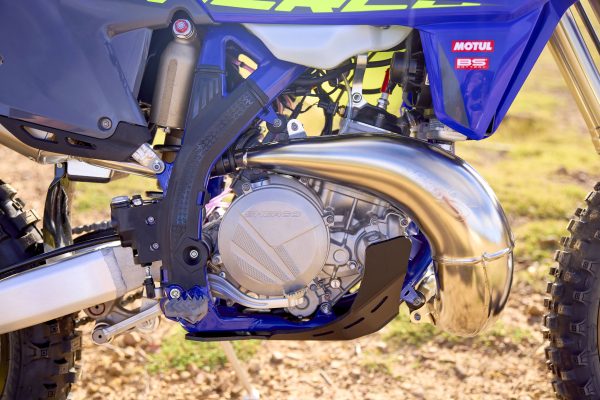
Brakes are a familiar strong point, with Brembo hydraulic calipers clamping onto a 260mm Galfer disc up front and a 220mm Galfer disc at the rear. It’s a powerful, predictable system, with a very easy-to-modulate feel at the lever.
The Sherco’s wheels are top quality too, running 1.60 x 21 and 2.15 x 18 black EXCEL Takasago rims, wrapped in Michelin Enduro Medium tyres straight from the factory.
Wheelbase is a compact 1480mm, ground clearance is a handy 355mm and the seat height measures a reasonable 950mm – putting it right in the ballpark for most serious off-road bikes.
The new slimmer bodywork makes the bike easier to move around on, and there’s less to get snagged up on compared to the older models.
Fit and finish is typically excellent, and the usual Sherco dual-map switch on the ’bar (Hard and Soft) works flawlessly if you need to mellow the bike out for tougher conditions.

There’s even a radiator thermo fan and expansion tank fitted as standard, meaning overheating isn’t something you’re likely to stress about on a tough day.
The 2025 Sherco SE 300 Factory is an absolute ripper. It’s easy to see why this bike remains one of the most popular 300 two-strokes around: it’s fast, it’s incredibly fun to ride, it’s polished and honestly, it sounds bloody glorious when it’s on song.
Beta RR 300 Race
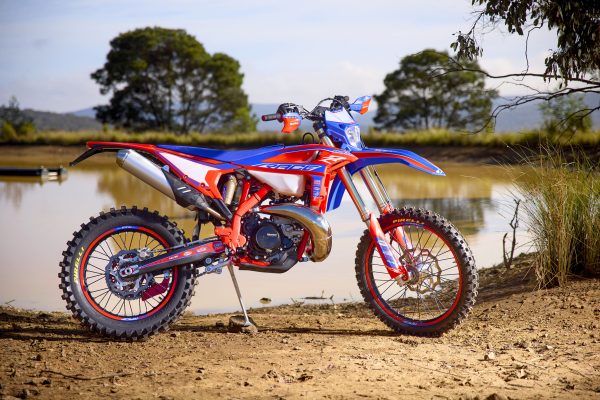
Onto bike number six now, and this time it’s the Beta RR 300 Race machine. This bike has one thing in mind – going fast. Beta’s 300 two-stroke line-up includes three models, but the Race model is exactly what it sounds like: a weapon built for serious competition. It’s a proven contender for the 300cc throne, and it’s already got a few world championships under its belt, so you know it means business.
For 2025, Beta has given the Race model a chassis makeover while keeping the engine unchanged from the major upgrades introduced in 2024.
The frame remains the molybdenum steel double-cradle design, now paired with updated plastics, lighter CNC-machined footpegs, a stronger front brake setup, a beefier rear axle and a slick new map switch tucked into the handlebar pad to keep it out of harm’s way.
As for the engine, it’s the most ‘traditional’ feeling two-stroke here – despite having a counter-balancer. Displacement is 292.6cc, running a 73.0mm bore and 69.9mm stroke, and you still get a proper Keihin PWK 36mm carburettor feeding the engine through a reed valve induction system.
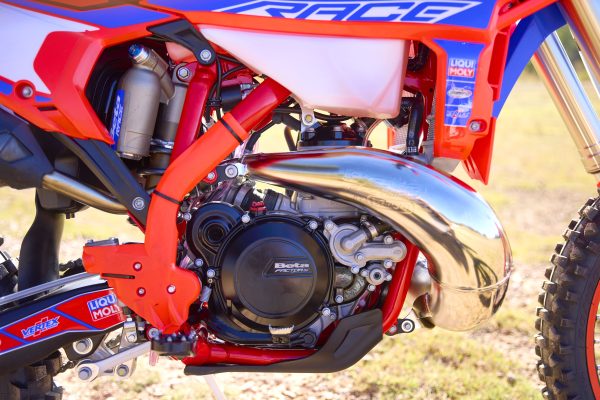
The Beta uses the BPV (Beta Progressive Valve) power valve system to broaden the powerband, and the unique twin-spark cylinder head (with twin NGK MR7BI-8 plugs) plays a big part in the engine’s crisp response and strong torque.
This is also the only bike here still running pre-mix fuel – no oil injection like the X-Pro – and honestly, it feels a bit old-school and awesome because of it.
First off, Beta Australia had this thing jetted absolutely spot-on. No bog, no hesitation, just pure crispness. The power delivery is fantastic: super strong off the bottom, ripping through the midrange, and pulling right up into the top without becoming unmanageable.
Despite being probably the most responsive bike here when you crack the throttle, it never feels like it’s going to tear your arms off. Thanks to the twin-spark head and perfect carb tuning, you can short-shift the Beta through third and fourth gear and it just pulls – an absolute gem for tight terrain.
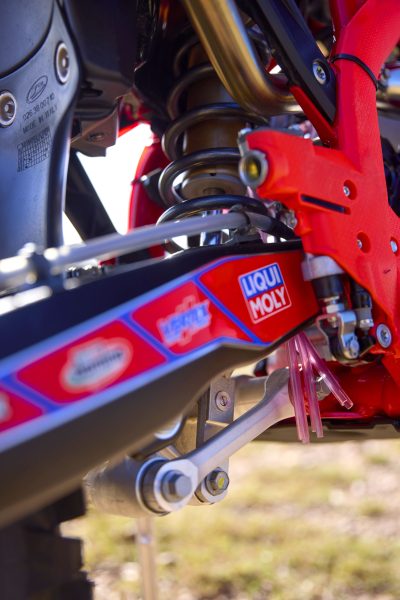
On the suspension front, the Beta doesn’t disappoint either. Up front you get a fully adjustable 48mm KYB closed-cartridge fork offering 300mm of travel, while at the rear there’s a KYB C46 RCU shock paired to a progressive linkage system, delivering 287mm of travel.
The suspension is definitely on the firmer side – no doubt about it – but it matches the race intent of the bike perfectly. The front end gives excellent feel when you’re pushing hard at speed, and the rear shock does a great job transferring drive to the ground. That said, if you prefer slow, technical crawling, the Beta Race might feel a bit stiff – in that case, the softer-sprung X-Pro model might be more up your alley.
The updated chassis and plastics give the bike a more unified, polished feel. Seat height is 950mm, but the big news is that Beta finally listened and added more seat foam – no longer does your backside feel like it’s been run over by a truck after a long ride.
Wheelbase measures 1482mm, ground clearance sits at a healthy 340mm, and the Beta runs standard enduro sizing with a 21×1.6 front rim and 18×1.85 rear, wrapped in 90/90-21 and 140/80-18 tyres respectively.

Braking is handled by quality Nissin hardware clamping onto a 260mm front wave disc and a 240mm rear disc. Stopping power is excellent, predictable and confidence-inspiring – a must when you’re tapping into the fire-breathing top end of this thing.
Other practical touches include a decent-sized 9.5L fuel tank (with a 2.3L reserve), a Kokusan AC ignition system with digital CDI, and electric start that reliably fires the bike to life without any fuss.
Lubrication is still old-school pre-mix (despite the “Mixing with electrical pump” note from specs – the Race model sticks to mix-your-own).
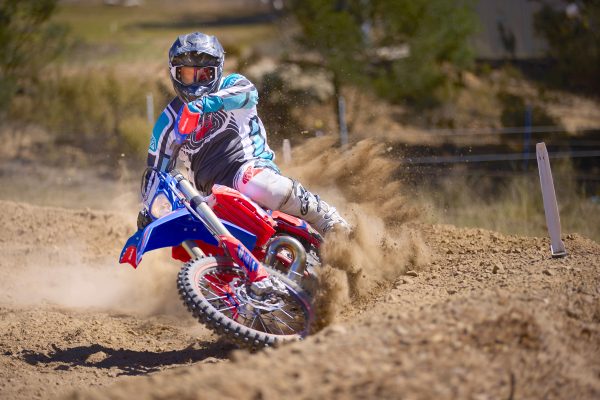
The 2025 Beta RR 300 Race is a serious contender for the 300cc two-stroke crown. It’s crisp, it’s fast, it feels alive – and most importantly, it’s an absolute blast to ride.
Built to be pushed hard, yet manageable enough to enjoy all day, it’s easy to see why the Beta 300 RR Race continues to be one of the true favourites in the hard-enduro and off-road scene.
GASGAS EC 300
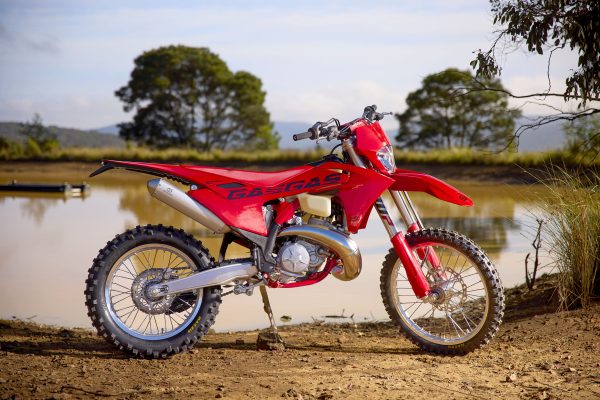
Finally, we have the GASGAS EC 300 – the third and final bike entered from the Austrian camp. This one’s often known as the ‘fun’ or ‘budget’ bike of the KTM Group trio. It shares the same 293.1cc TBI engine platform as the KTM and Husky, with a 72mm bore and 72mm stroke, running Vitesco Technologies EMS and Keihin EFI through a 39mm throttle body. But a few key parts have been switched out – or simply left off – to keep the price lower and make the EC 300 more accessible to everyday riders.
The major differences? The GASGAS runs a WP XPLOR open-cartridge fork up front (Ø 48mm, 300mm travel) rather than the more expensive closed-cartridge systems of its siblings. It uses forged aluminium triple clamps instead of machined ones, skips the map switch, doesn’t come with handguards or a bash plate, and rolls on slightly more basic wheels. The braking and clutch systems are also different, with Braktec hydraulics handling stopping and clutch duties instead of Brembo.
After the massive overhaul in 2024, the 2025 GASGAS machines only get a few small updates – refinements to the swingarm, revised shock linkage, a stronger rear brake caliper and a fresh new look. Parked next to the KTM and Husky, yeah, the GASGAS does look a little plain – but with more than $3300 in savings compared to the KTM 300 EXC, many riders will forgive the red machine’s simpler appearance.
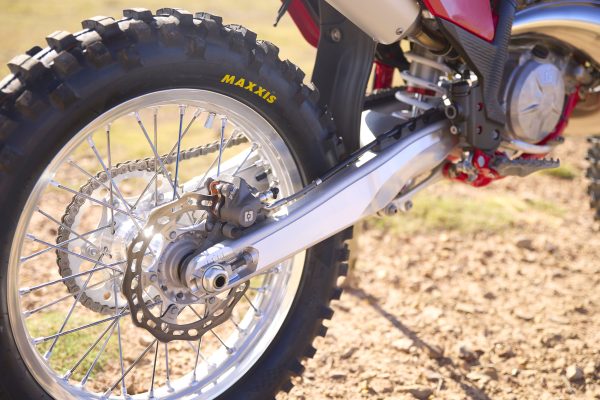
On the track, the EC 300 feels decent, but it’s easily the softest and most laidback bike of the group. The engine – despite being the same basic design – feels noticeably more choked up than its Austrian brothers, mostly due to a more restrictive airbox setup. In fact, at times, it feels closer to a 250 in power delivery rather than a full-blown 300. Don’t get me wrong, it’s still a great engine, just milder. With some simple airbox mods, we reckon you could easily wake it up and unlock a lot more response.
One thing that was missed was the lack of a map switch. There’s none fitted stock, but one can be added aftermarket, which is good news for those who want more tuning options on the fly. The GASGAS’s engine is definitely aimed more toward the trail-oriented rider: it’s super easy to ride, non-intimidating and very forgiving. If you’re new to the enduro scene, the EC 300 could be the perfect launchpad.
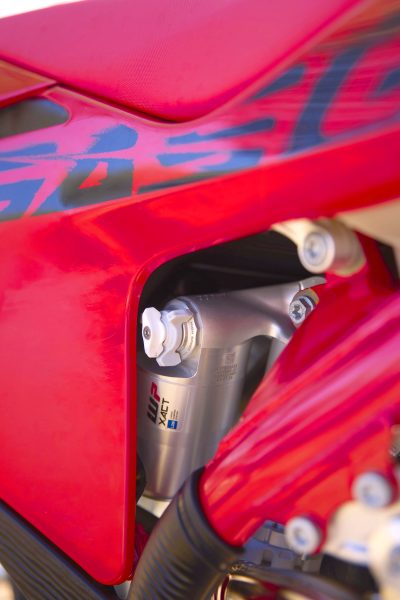
Much like the engine, the suspension package is on the soft side too. The WP XPLOR open-cartridge fork – while one of the better versions we’ve felt – still has that classic soft XPLOR feel. It’s plush at slow speeds, works great through rocky, technical sections, but blows through the stroke quite quickly if you’re hammering at race pace. The WP XACT Monoshock with linkage (300mm travel rear) matches well with the fork’s character: soft but manageable, producing excellent traction and making the bike easy to control across technical trails.
For trail riding, the GASGAS is a comfy couch – it’s definitely the bike that’ll beat you up the least after a full day in the saddle. The Neken handlebar (28/22mm) gives a comfortable riding position, and the seat height at 956mm is slightly lower than its Austrian cousins, making it a bit more accessible for shorter riders too. Ground clearance is solid at 354mm, and the wheelbase is 1489mm, giving it a nicely balanced feel through tight trails.
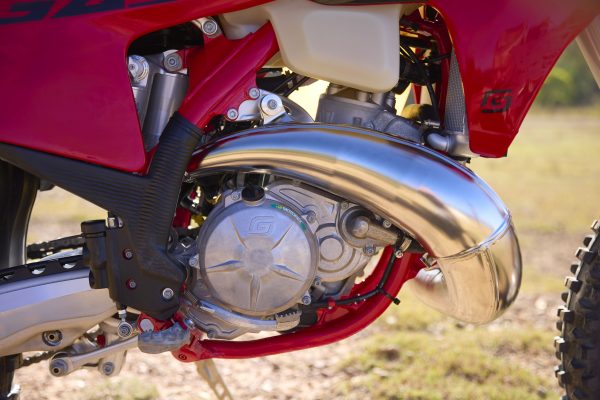
One real gripe? No handguards fitted as standard. It’s a $30-$50 fix, but after smashing your knuckles on enough low-hanging branches, you start wishing they were stock. At least the Braktec brakes – once a sore point when they first launched – are now much improved. Braking feel is strong and predictable, and the aluminium silencer keeps noise levels nice and manageable while shaving a bit of weight.
The 2025 GASGAS EC 300 easily wins the ‘trailbike’ award among the group. It’s light (107.6kg dry), friendly, easygoing and a fantastic bike for someone who wants a fuss-free entry into the world of 300 two-strokes without the big-ticket KTM or Husky price tag.
As for the future of the GASGAS brand under KTM Group ownership – well, time will tell. But for now, the EC 300 still has a solid place for riders who just want to hit the trails and have fun without overcomplicating things.

Winner, winner!
Oh baby, here we go! So, which bike is the 2025 ADB 300 two-stroke ‘Race and Trail’ Shootout winner?
Well, by the slimmest of margins, let’s say congrats to the 2025 KTM 300 EXC!
What a turnaround for the KTM machine after a few so-so years in the 300cc class. It’s been a long road of trials and tribulations with the TPI and now TBI bikes, but it looks like the 2025 version has finally set the new benchmark for what a 300 two-stroke needs to be.
A strong, useable engine package paired with the all-round solid capability of the new WP suspension, plus the updates to the chassis and the striking look of the Champion Edition bike – it all sealed the deal for 2025.
Coming in a ridiculously close second place was the Beta 300 Race. Featuring the strongest engine of the group and a suspension package to match it, the Beta came painfully close to taking the crown – we’re talking within 0.2 of a point! It was almost a tie!
Rounding out the podium was the super fun Sherco 300 SE Factory. Yet another epic engine and suspension combo, with a fit and finish to match.
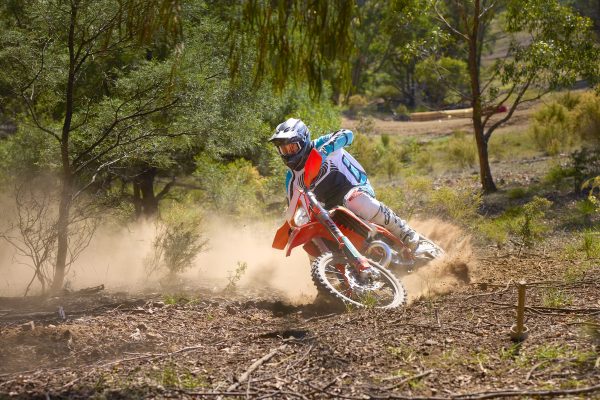
If there’s one big takeaway from this test, it’s this: it’s clear at the top which manufacturers are putting in the time and effort to keep developing their bikes. KTM, Beta and Sherco are massive players in the 300 two-stroke world, backed by mountains of racing experience across both enduro and hard enduro. These bikes are so refined now… and that’s obvious the moment you throw a leg over them.
That’s not taking anything away from the other bikes. The Husky could easily have been right in the mix if we’d had a 300cc version, and the TM, with a bit more fine-tuning and time under its belt, could easily edge closer to the front.
The GASGAS is happily carving its niche in the trail sector. And the Fantic? Let’s just say you wouldn’t guess it’s a rookie in this class. Give the XE 300 a few more years out on the trails, and the new kid on the block could definitely become a big threat to the three bikes currently at the top.
There’s no denying just how strong the 300 two-stroke market is right now. Every single one of these bikes is an incredible bit of kit – and they are all unbelievably fun to ride. They’re light, agile, fast as hell and an absolute must-have if you love trail riding with your mates and tackling the gnarliest stuff you can find.
It was an epic experience riding all of these machines. But at the end of the day, there could only be one winner – and that was the KTM 300 EXC. Champion Edition by name, champion by nature.
